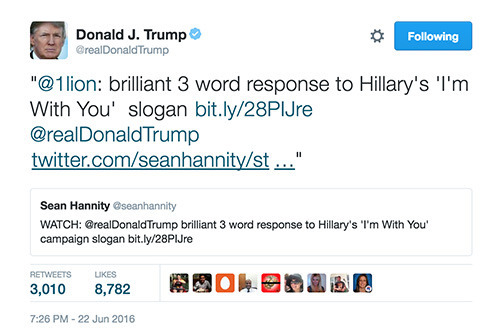Trump’s Feed is the brainchild of Philip Bump over at the Washington Post. It follows everyone that Trump is following, and retweets their latest tweets; the idea is to simulate what Trump sees when he opens Twitter. Currently, it’s full of tweets like this:
A source close to Bannon :
"Democrats have seized control of the White House. Kelly, HR, Gary, Jared & Ivanka are all Democrats."
— Kevin Cirilli (@kevcirilli) August 18, 2017
Here's a great sign: Wall Street traders ARE CHEERING the departure of Bannon.
— Ann Coulter (@AnnCoulter) August 18, 2017
(That one’s true, stocks rose on news of his departure.)
Bannon leaving WH – no surprise. Gen. Kelly is calling personnel shots, wants a calmer environment. Bannon simply too hot ideologically.
— Bill O'Reilly (@billoreilly) August 18, 2017
It's true: as far as I know, Bannon was the only one inside the White House who openly expressed contempt for the Kochs & other Big Donors. https://t.co/8UNR8WI8kv
— Jane Mayer (@JaneMayerNYer) August 18, 2017
Those who are upset by Steve Bannon's departure can at least take solace that he'll likely be replaced by somebody from Goldman Sachs.
— Stefan Molyneux (@StefanMolyneux) August 18, 2017
If @realDonaldTrump didn't like the media giving Steve Bannon all credit, instead of firing him, he should've hired 10 more like him.
— Ann Coulter (@AnnCoulter) August 18, 2017
It’s an interesting range of opinions, with some happy to have Bannon out and others thinking this is a dramatic turn leftward. Bannon and Breitbart are signalling they’re ready to fight the White House, though I’m not sure how seriously to take that. Corey Lewandowski (maybe) came back, Trump was still interested in talking to Michael Flynn months after firing him, and Bannon’s friends aren’t entirely reliable. There’s also the slight problem of trying to invoke the alt-Right when you’ve said this:
I asked Bannon about the connection between his program of economic nationalism and the ugly white nationalism epitomized by the racist violence in Charlottesville and Trump’s reluctance to condemn it. Bannon, after all, was the architect of the strategy of using Breitbart to heat up white nationalism and then rely on the radical right as Trump’s base.
He dismissed the far right as irrelevant and sidestepped his own role in cultivating it: “Ethno-nationalism—it’s losers. It’s a fringe element. I think the media plays it up too much, and we gotta help crush it, you know, uh, help crush it more.”
“These guys are a collection of clowns,” he added.
And yet he was also aggressively courting those clowns not too long ago. Do they still side with him? Would an exodus mean Brietbart will fade out? Are part of his base going to peel away if they think Trump is turning leftwards, or will this bring some calm to the White House water cooler? Firing Bannon was a table-flip; all the pieces are flying around, and no-one is sure how they’ll land. About the only thing we can say is that the results will be interesting.


